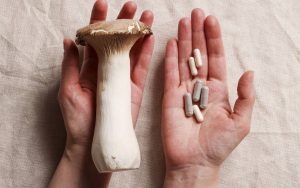How to Grow Your Own Gourmet Mushrooms at Home: A Step-by-Step Guide
Growing your own gourmet mushrooms at home is a fun and rewarding way to enjoy fresh, flavorful fungi while gaining a deeper appreciation for the world of mushrooms. Whether you’re a culinary enthusiast or someone interested in the health benefits of mushrooms, this step-by-step guide will walk you through the process of cultivating gourmet varieties right in your home. We’ll also explore how Microdose Mushrooms fit into this growing trend and why they’re gaining popularity.
Why Grow Gourmet Mushrooms at Home?

Gourmet mushrooms like Shiitake, Oyster, and Lion’s Mane are prized for their rich flavors, nutritional benefits, and versatility in the kitchen. Growing them at home allows you to:
- Enjoy Fresh Mushrooms: Store-bought mushrooms often lack the freshness and flavor that home-grown varieties offer.
- Save Money: Gourmet mushrooms can be expensive at the grocery store. Growing your own is cost-effective.
- Ensure Quality: You control the growing environment, ensuring your mushrooms are free from pesticides and other chemicals.
- Experiment with Varieties: Explore different gourmet species that may not be available in local stores.
- Explore Microdosing: For those interested in the potential mental health benefits of Microdose Mushrooms, growing certain types of mushrooms can provide a controlled and natural source.
Step 1: Choosing Your Mushroom Variety
The first step in growing mushrooms at home is selecting the variety you want to cultivate. Here are some popular gourmet mushrooms that are beginner-friendly:
- Oyster Mushrooms (Pleurotus ostreatus): Easy to grow and available in several colors, including white, pink, and blue. They have a mild, savory flavor.
- Shiitake Mushrooms (Lentinula edodes): Known for their meaty texture and rich, umami flavor. Shiitake mushrooms are commonly used in Asian cuisine.
- Lion’s Mane Mushrooms (Hericium erinaceus): These mushrooms have a unique, fluffy appearance and a seafood-like flavor, often compared to crab or lobster. They are also associated with cognitive benefits, making them popular among those interested in Microdose Mushrooms.
- Button Mushrooms (Agaricus bisporus): These are the common white mushrooms found in stores, but they can be grown at home for a fresher taste.
Step 2: Preparing Your Growing Environment
Mushrooms thrive in environments that mimic their natural habitats—damp, dark, and cool. Here’s how to create the ideal growing environment:
- Choose the Right Location: Find a space in your home that is cool, dark, and humid. Basements, closets, or under-sink areas are often ideal.
- Control Temperature: Most gourmet mushrooms grow best between 55-65°F (13-18°C). Use a thermometer to monitor the temperature in your growing area.
- Manage Humidity: Mushrooms require high humidity (70-90%). You can maintain humidity by misting the growing area with water daily or using a humidifier.
- Provide Ventilation: Ensure the growing area has good airflow to prevent mold growth and allow the mushrooms to “breathe.”
Step 3: Preparing Your Growing Medium
The growing medium, also known as the substrate, is the material in which mushrooms grow. Different mushroom species have different substrate preferences:
- Oyster Mushrooms: Oyster mushrooms thrive on straw, coffee grounds, or hardwood sawdust.
- Shiitake Mushrooms: Shiitake mushrooms prefer hardwood logs or sawdust.
- Lion’s Mane Mushrooms: This species does well on hardwood sawdust or a mix of sawdust and bran.
How to Prepare the Substrate:
- Sterilization: To avoid contamination, the substrate should be sterilized before use. This can be done by boiling, steaming, or using a pressure cooker to kill any unwanted organisms.
- Inoculation: After sterilizing, the substrate needs to be inoculated with mushroom spawn (the equivalent of seeds in mushroom cultivation). Mix the spawn thoroughly into the substrate.
Step 4: Inoculating and Incubating
Once the substrate is prepared and inoculated, it’s time to let the mushrooms grow:
- Fill Containers: Place the inoculated substrate into growing containers. These can be plastic bags, buckets, or trays, depending on the type of mushroom.
- Incubation: Store the containers in your designated growing area, keeping the environment dark and maintaining appropriate temperature and humidity levels. During incubation, the mushroom mycelium (the vegetative part of the fungus) will spread through the substrate.
- Monitoring: Check the containers regularly for signs of mycelium growth, which looks like white, thread-like filaments spreading through the substrate.
Step 5: Fruiting
After the mycelium has colonized the substrate, it’s time to trigger fruiting, which is when the actual mushrooms begin to grow:
- Introduce Light: Mushrooms don’t need much light, but a small amount of indirect light can help trigger fruiting. A simple 12-hour light/dark cycle works well.
- Increase Humidity: Boost the humidity by misting the substrate more frequently or by using a humidity tent (a plastic cover with ventilation holes).
- Lower Temperature: For some mushroom species, lowering the temperature slightly can help initiate fruiting.
- Patience: Depending on the species, mushrooms will start to appear within a few days to a few weeks. Keep misting and maintaining the environment during this period.
Step 6: Harvesting Your Gourmet Mushrooms
Once your mushrooms have grown to the desired size, it’s time to harvest:
- When to Harvest: Harvest mushrooms when the caps are fully opened but before they start to drop spores. This ensures the best flavor and texture.
- How to Harvest: Gently twist the mushrooms at the base to remove them from the substrate. Use a sharp knife if needed.
- Post-Harvest Care: After harvesting, you can use the substrate for another flush (a new batch of mushrooms) by continuing to care for it. Most substrates can produce multiple flushes.
Step 7: Enjoying and Preserving Your Mushrooms
Freshly harvested mushrooms can be enjoyed in various dishes, from stir-fries to soups. If you have a surplus, consider drying them:
- Drying Mushrooms: Drying is a great way to preserve your mushrooms for long-term storage. Simply slice them thinly and use a food dehydrator, or air-dry them in a well-ventilated area.
- Using Dried Mushrooms: Rehydrate dried mushrooms by soaking them in warm water before cooking. They retain their flavor and nutritional benefits, making them perfect for adding depth to dishes.
Microdose Mushrooms: A Growing Trend
In addition to the culinary joys of growing gourmet mushrooms, there’s growing interest in the mental health benefits of Microdose Mushrooms. Microdosing involves consuming very small amounts of certain mushrooms, like Psilocybin mushrooms, to potentially improve mental clarity, creativity, and mood without the psychoactive effects associated with higher doses. While this trend is still under research and comes with legal considerations depending on your location, it highlights the broadening appeal of mushroom cultivation.
For those interested in exploring this aspect of mushrooms, it’s crucial to understand the legalities and the differences between gourmet and psychoactive mushrooms. Growing gourmet varieties like Oyster, Shiitake, or Lion’s Mane is completely legal and offers a safe, rewarding way to start your journey into the fascinating world of mushrooms.
Conclusion: Start Growing Your Gourmet Mushrooms Today
Growing your own gourmet mushrooms at home is an accessible and enriching hobby that provides fresh, delicious mushrooms year-round. With the right environment, a little patience, and a love for the process, you can cultivate a variety of mushrooms that elevate your culinary creations and perhaps even explore the benefits of Microdose Mushrooms.
At Shroom Wonders, we’re passionate about the magic of mushrooms, whether it’s through cultivating your own or exploring their many health benefits. Start your mushroom-growing journey today, and discover how easy and rewarding it can be to bring a bit of nature’s bounty into your home.



